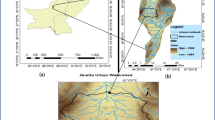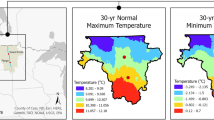Abstract
A simple modification of the volume balance equation of the IPARM model is presented to facilitate the use of variable inflow. Traditional approaches for estimating infiltration from advance and/or runoff have merely considered the constant or step inflow case. Whenever this assumption is violated, significant uncertainty is introduced into the estimated infiltration parameters. Evaluation of the procedure with a number of data sets has demonstrated significant improvements in the estimates of infiltration parameters. Furthermore, the technique has shown that a portion of the apparent variability in estimated soil intake rates between furrows in the same field is a consequence of the constant inflow assumption. Accounting for the variable inflow to estimate infiltration functions, both standardised the shape of the infiltration curve and reduced the magnitude of the variation between curves. The proposed technique remains restricted by limitations similar to that of other volume balance models but offers greater performance under typical inflow variations often experienced in practice.






Similar content being viewed by others
References
Alazba AA (1999) Simulating furrow irrigation with different inflow patterns. J Irrigat Drain Eng 125(1):12–18
DeTar WR (1989) Infiltration function from furrow stream advance. J Irrigat Drain Eng 115(4):722–733
Eldeiry AA, Garcia LA, El-Zaher ASA, Kiwan ME-S (2005) Furrow irrigation system design for clay soils in arid regions. Appl Eng Agric 21(3):411–420
Elliott RL, Walker WR, Skogerboe GV (1983) Infiltration parameters from furrow irrigation advance data. Trans ASAE 26(6):1726–1731
Gharbi A, Daghari H, Cherif K (1993) Effect of flow fluctuations on free draining, sloping furrow and border irrigation systems. Agric Water Manage 24(4):299–319
Gillies MH, Smith RJ (2005) Infiltration parameters from surface irrigation advance and run-off data. Irrigat Sci 24(1):25–35
Guardo M, Oad R, Podmore TH (2000) Comparison of zero-inertia and volume balance advance-infiltration models. J Hydraulic Eng 126(6):457–465
Hornbuckle JW (1999) Modeling furrow irrigation on heavy clays, high water tables and tiled drained soils using sirmod in the murrumbidgee irrigation area. Undergraduate Thesis, University of New England, Armidale, NSW, Australia
Jurriëns M, Lenselink KJ (2001) Straightforward furrow irrigation can be 70% efficient. Irrigat Drain 50(3):195–204
Mailhol JC, Priol M, Benali M (1999) A furrow irrigation model to improve irrigation practices in the gharb valley of morocco. Agric Water Manage 42(1):65–80
McClymont DJ, Smith RJ (1996) Infiltration parameters from optimization on furrow irrigation advance data. Irrig Sci 17(1):15–22
Raine SR, McClymont DJ, Smith RJ (1997) The development of guidelines for surface irrigation in areas with variable infiltration. Australian Society of Sugar Cane Technologists, Cairns, Australia, pp 293–301
Renault D, Wallender WW (1996) Initial-inflow-variation impacts on furrow irrigation evaluation. J Irrigat Drain Eng 122(1):7–14
Scaloppi EJ, Merkley GP, Willardson LS (1995) Intake parameters from advance and wetting phases of surface irrigation. J Irrigat Drain Eng 121(1):57–70
Schwankl LJ, Raghuwanshi NS, Wallender WW (2000) Furrow irrigation performance under spatially varying conditions. J Irrigat Drain Eng 126(6):355–361
Trout TJ, Mackey BE (1988) Inflow–outflow infiltration measurement accuracy. J Irrigat Drain Eng 114(2):256–265
Valiantzas JD (1997) Volume balance irrigation advance equation: Variation of surface shape factor. J Irrigat Drain Eng 123(4):307–312
Valiantzas JD (2000) Surface water storage independent equation for predicting furrow irrigation advance. Irrigat Sci 19(3):15–123
Walker WR (2003) Surface irrigation simulation, evaluation and design. Course Guide and Technical Documentation, Utah State University, Logan, Utah, 145
Walker WR (2005) Multilevel calibration of furrow infiltration and roughness. J Irrigat Drain Eng 131(2):129–136
Acknowledgments
The authors thank Dr John Hornbuckle CSIRO Land & Water for permission to use his furrow irrigation data.
Author information
Authors and Affiliations
Corresponding author
Additional information
Communicated by T. Trooien
Rights and permissions
About this article
Cite this article
Gillies, M.H., Smith, R.J. & Raine, S.R. Accounting for temporal inflow variation in the inverse solution for infiltration in surface irrigation. Irrig Sci 25, 87–97 (2007). https://doi.org/10.1007/s00271-006-0037-9
Received:
Accepted:
Published:
Issue Date:
DOI: https://doi.org/10.1007/s00271-006-0037-9




